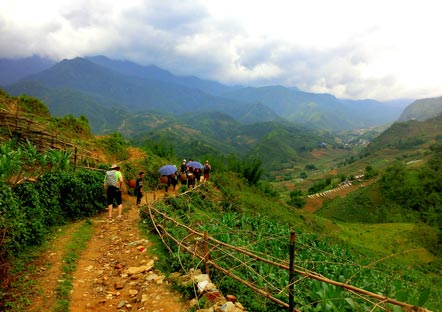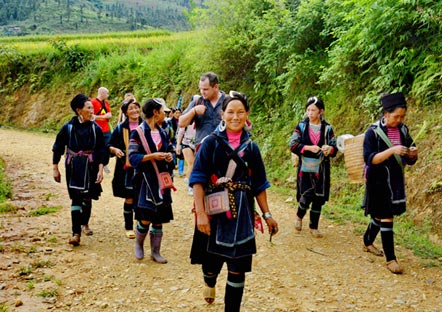Sapa is an attractive place for domestic and foreign tourists. Sapa has a cool weather all year around so it is suitable for those who want to relax and immerse into the nature. Besides, Sapa is also known as a trekking destination with spectacular landscape and mountains. Before planning a trip to Sapa, you should find more information about trekking in Sapa.
Hire a guide
There are full-day hikes and even half-day hikes (like Cat Cat Village) which you may want to attempt on your own, however, if you want to spend a few days experiencing the hillside I would recommend hiring a local guide who is familiar with the terrain, the changes in weather, and the best lookout spots.
Treks are easy to arrange once you arrive in Sapa, so don’t bother making bookings in advance as it’ll be cheaper to do so in person. I booked my guided tour through my hotel in Sapa, but you can also book tours through the main tourism office or the various tour operators found in town. Most of the guides are local and they speak great English, so know that you’re giving back to the local community when you book a trekking guide.

Pack light
In my personal experience, towels and bedding were not necessary. The accommodations arranged by my tour were at a small family-run guesthouse. It was a bit of an open-concept with lots of mattresses lined side by side and a mosquito net over top, but we had clean bedsheets, warm blankets for the night, and fresh towels. That really was all we needed. I saw a few people lugging around their own sleeping bags and heavy packs with who knows what…you really needn’t bother.
Also, keep in mind that the guide is not a porter (this is not Everest Base Camp) and he is not going to carry your bag for you. Only bring what you deem absolutely necessary. Remember, your bag may not feel heavy when you first try it out in your room, but it’ll only get heavier as the day progresses.

Wear sturdy shoes
Our guide took us “off-the-beaten-track”, quite literally. There were times when we were scrambling up the mountain on all fours, hopping across ditches, and having our bodies whipped by branches as we cut across a bamboo forest. It was demanding and you’ll want good footwear.
I brought a pair of running shoes with good support and a solid grip. Hiking boots might be something to consider if you’re planning something longer than a 2 day trek, like say the summit of Mount Fansipan.
Aside from my runners, I brought a pair of flip flops to wear at the end of the day – my feet were tired and craving some wiggle room after a long day of trekking in Sapa! I’ll also admit I did wear the flip flops on the last day of the hike when we were back on even terrain, but I would NOT recommend attempting the whole hike in flip flops lest you end up with a sprained ankle. Now that would be one way to ruin the rest of your travel plans…
As a side note, there are lots of shops in Sapa that both rent and sell trekking gear. If you’re doing some travel around Southeast Asia prior to your visit to Sapa and don’t feel like lugging around boots and hiking poles, know that those things can be found in the town at affordable rates.
Umm, you’ll notice Sam had a bit of a 70s vibe by the time we reached Vietnam…

Bring double the water you think you’ll need
Actually make that triple. You will get thirsty and you’ll be guzzling more water than a camel. It’s a horrible feeling realizing you’ve just drank the last drop of your water and there are still another 2 hours of hiking ahead of you. We did pass a few makeshift stands selling water as we got closer to the towns, so I’m not saying you’ll die of thirst, merely that it could be a while until you get a drink…

Get used to the touts
If you’re spending a few days in Sapa, you’ll notice that for the women of the Hmong tribe touting is serious business. If you are hoping the touting will stop once you leave Sapa, think again. Despite making it clear that we had no intention of purchasing any more souvenirs, we had women walk alongside us for hours. Things started off friendly enough with them asking questions and practicing their English, but there was always a pitch at the end and their sales tactics were a bit aggressive. I’m not trying to sound harsh – I realize that they also have to earn their living – but I am sharing the realities of my experience so that others aren’t shocked by this when they visit.

And lastly, don’t forget your camera!
The scenery in Sapa and the surrounding region in stunning so you’ll want to make sure you bring your camera and that the battery is fully charged.
